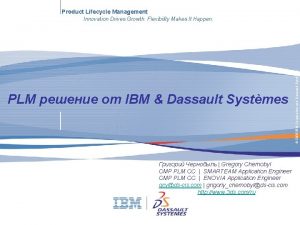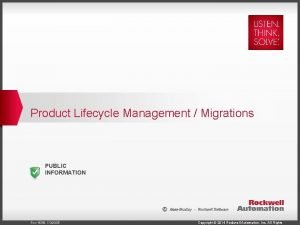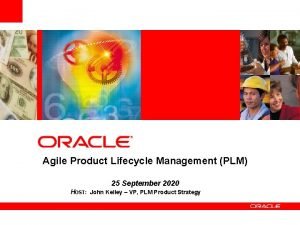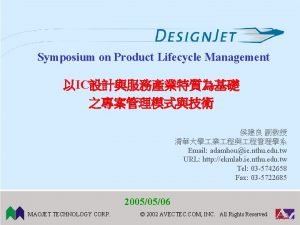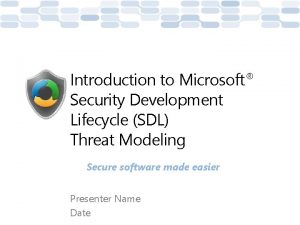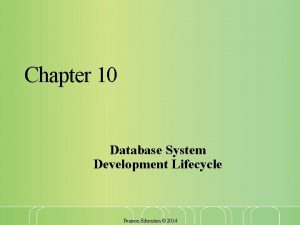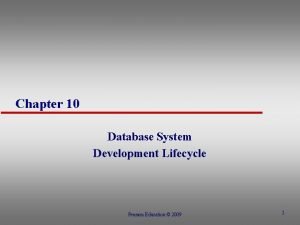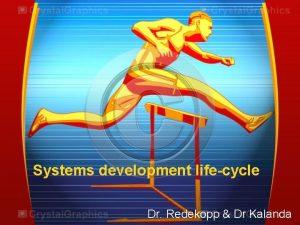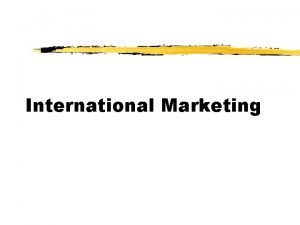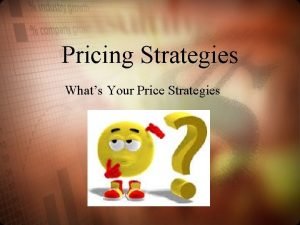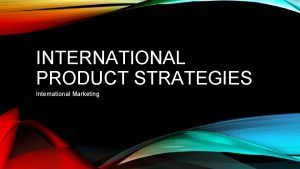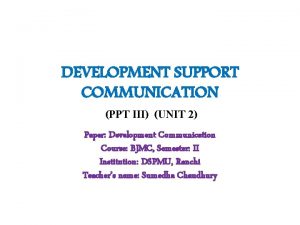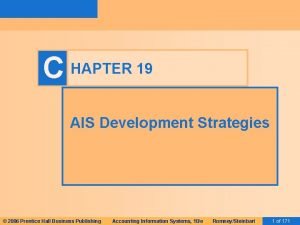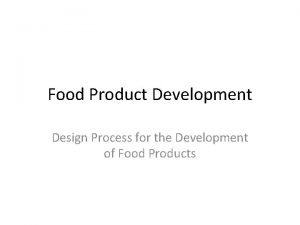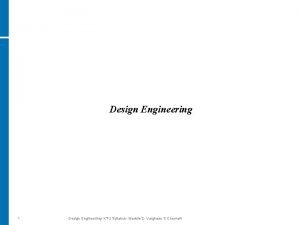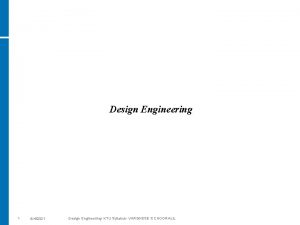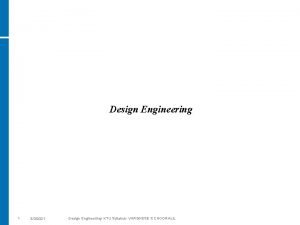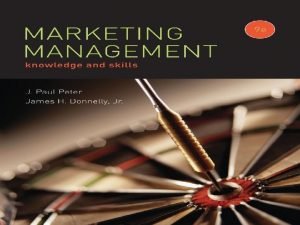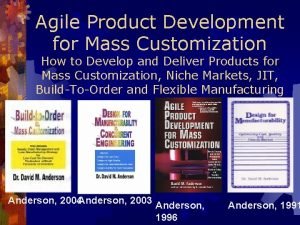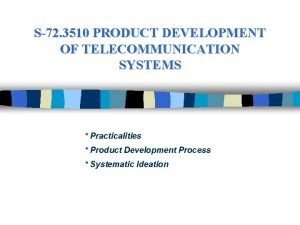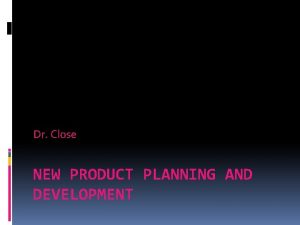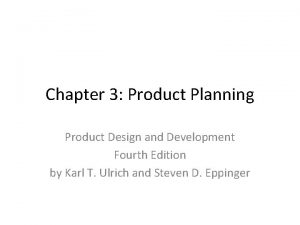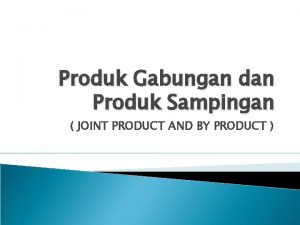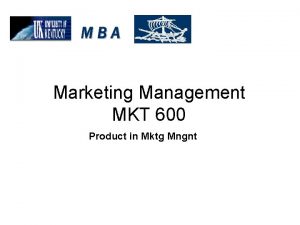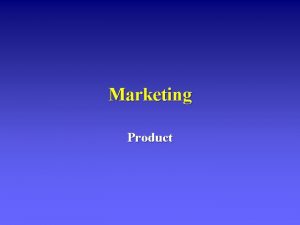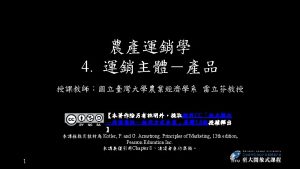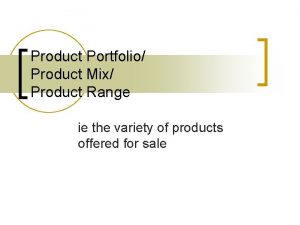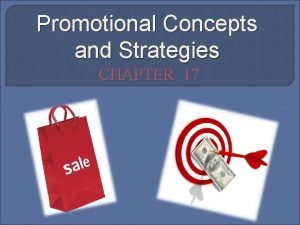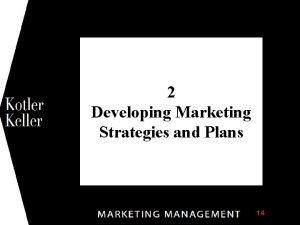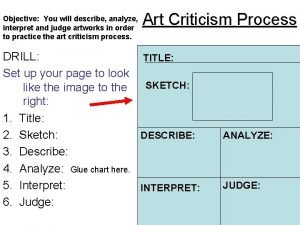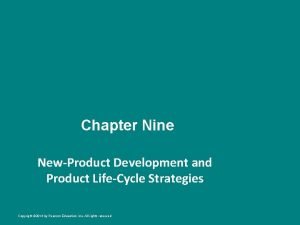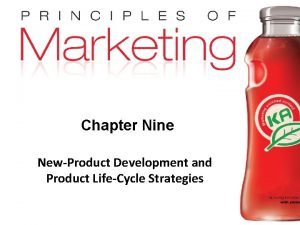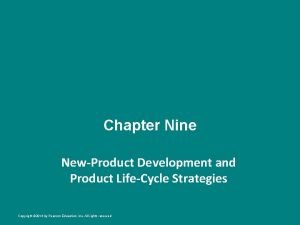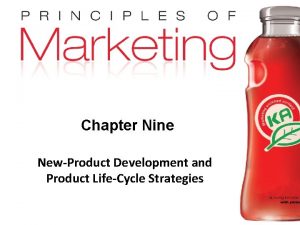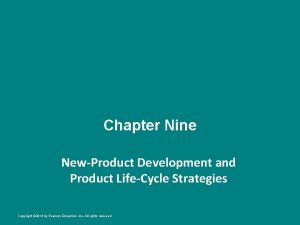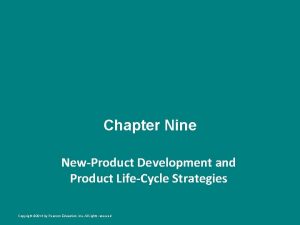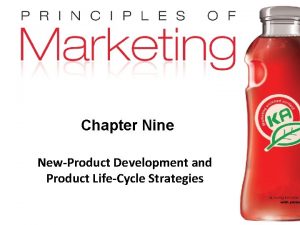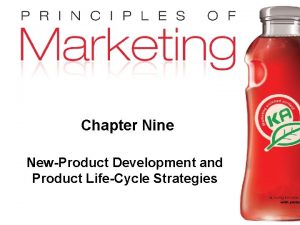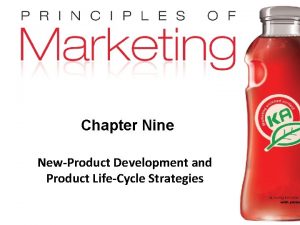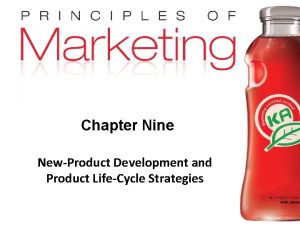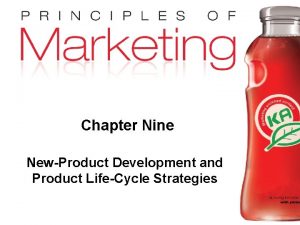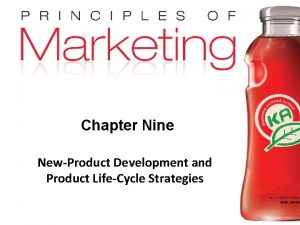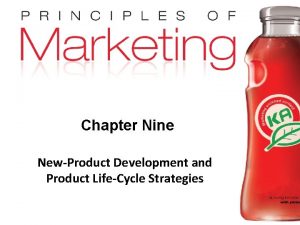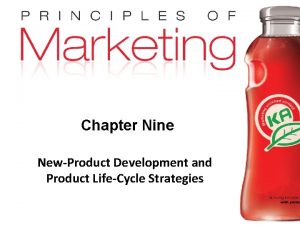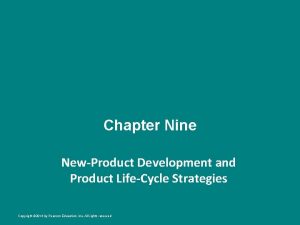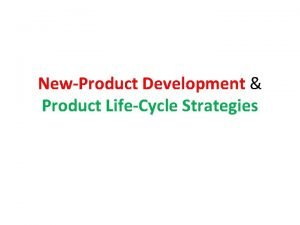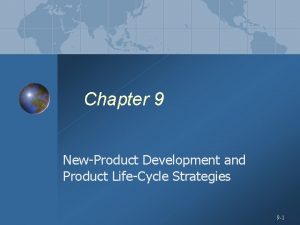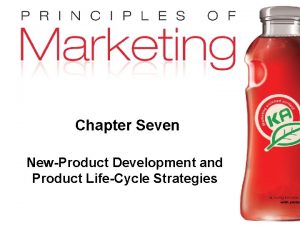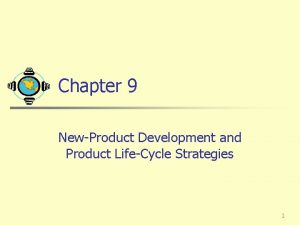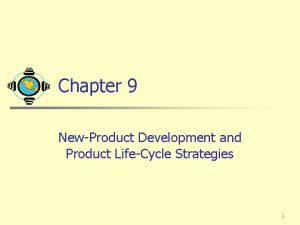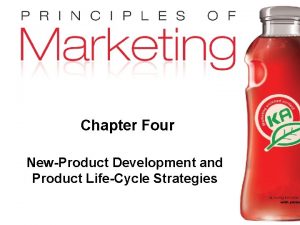Chapter Nine NewProduct Development and Product LifeCycle Strategies
















































- Slides: 48

Chapter Nine New-Product Development and Product Life-Cycle Strategies Copyright © 2009 Pearson Education, Inc. Publishing as Prentice Hall Chapter 9 - slide

New-Product Development and Product Life-Cycle Strategies Topic Outline • New-Product Development Strategy • New-Product Development Process • Managing New-Product Development • Product Life-Cycle Strategies • Additional Product and Service Considerations Copyright © 2010 Pearson Education, Inc. Publishing as Prentice Hall Chapter 9 - slide 2

New-Product Development Strategy Two ways to obtain new products Acquisition refers to the buying of a whole company, a patent, or a license to produce someone else’s product New product development refers to original products, product improvements, product modifications, and new brands developed from the firm’s own research and development efforts Copyright © 2010 Pearson Education, Inc. Publishing as Prentice Hall Chapter 9 - slide 3

New-Product Development Reasons for new product failure Overestimation of market size Poor design Incorrect positioning Wrong timing Priced too high Ineffective promotion Management influence High development costs Competition Copyright © 2010 Pearson Education, Inc. Publishing as Prentice Hall Chapter 9 - slide 4

New-Product Development Process Major Stages in New-Product Development Copyright © 2010 Pearson Education, Inc. Publishing as Prentice Hall Chapter 9 - slide 5

New-Product Development Process Idea Generation Idea generation is the systematic search for new-product ideas Sources of new-product ideas • Internal • External Ex. IBM recently held an “Innovation Jam” Generated 46, 000 ideas, Of which IBM planned to develop only 10 Copyright © 2010 Pearson Education, Inc. Publishing as Prentice Hall Chapter 9 - slide 6

New-Product Development Process Idea Generation Internal sources refer to the company’s own formal research and development, management and staff, and intrapreneurial programs External sources refer to sources outside the company such as customers, competitors, distributors, suppliers, and outside design firms Copyright © 2010 Pearson Education, Inc. Publishing as Prentice Hall Chapter 9 - slide 7

New-Product Development Process Idea Screening • Identify good ideas and drop poor ideas • R-W-W ( real, win, worth it )Screening Framework: – Is it real? – Can we win? – Is it worth doing? The company should be able to answer yes to all the questions before developing the new product idea further Copyright © 2010 Pearson Education, Inc. Publishing as Prentice Hall Chapter 9 - slide 8

New-Product Development Process Concept Development and Testing Product idea is an idea for a possible product that the company can see itself offering to the market Product concept is a detailed version of the idea stated in meaningful consumer terms Product image is the way consumers perceive an actual or potential product Copyright © 2010 Pearson Education, Inc. Publishing as Prentice Hall Chapter 9 - slide 9

New-Product Development Process Concept Development and Testing Concept testing refers to testing new-product concepts with groups of target consumers Copyright © 2010 Pearson Education, Inc. Publishing as Prentice Hall Chapter 9 - slide 10

New-Product Development Process Marketing Strategy Development • Marketing strategy development refers to the initial marketing strategy for introducing the product to the market • Marketing strategy statement includes: – Description of the target market – Value proposition( the product planned price, distribution and marketing budget for the year – Sales and profit goals Copyright © 2010 Pearson Education, Inc. Publishing as Prentice Hall Chapter 9 - slide 11

New-Product Development Process Marketing Strategy Development Business analysis involves a review of the sales, costs, and profit projections to find out whether they satisfy the company’s objectives _ if they do , the product can move to the product development stage Copyright © 2010 Pearson Education, Inc. Publishing as Prentice Hall Chapter 9 - slide 12

New-Product Development Process Marketing Strategy Development Product development involves the creation and testing of one or more physical versions by the R&D or engineering departments • Requires an increase in investment • Ex. Gillette uses employeevolunteers to test new shaving products. Copyright © 2010 Pearson Education, Inc. Publishing as Prentice Hall Chapter 9 - slide 13

New-Product Development Process Marketing Strategy Development • Test marketing is the stage at which the product and marketing program are introduced into more realistic marketing settings • Provides the marketer with experience in testing the product and entire marketing program before full introduction Copyright © 2010 Pearson Education, Inc. Publishing as Prentice Hall Chapter 9 - slide 14

New-Product Development Process Marketing Strategy Development For example : KFC test marketed its new kentucky grilled chicken product for three years before rolling it out widely. Says the chain’s president, “ we had to get it right “ Copyright © 2010 Pearson Education, Inc. Publishing as Prentice Hall Chapter 9 - slide 15

New-Product Development Process Types of Test Markets Standard test markets Controlled test markets Simulated test markets Copyright © 2010 Pearson Education, Inc. Publishing as Prentice Hall Chapter 9 - slide 16

New-Product Development Process Types of Test Markets • Standard test markets are small representative markets where the firm conducts a full marketing campaign and uses store audits, consumer and distributor surveys, and other measures to gauge product performance. Results are used to forecast national sales and profits, discover product problems, and fine-tune the marketing program. • Controlled test markets are panels of stores that have agreed to carry new products for a fee. In general they are less expensive than standard test market, faster than standard test markets, but competitors gain access to the new product. Copyright © 2010 Pearson Education, Inc. Publishing as Prentice Hall Chapter 9 - slide 17

New-Product Development Process Types of Test Markets • Simulated test markets are events where the firm will create a shopping environment and note how many consumers buy the new product and competing products. Provides measure of trial and the effectiveness of promotion. Researchers can interview consumers Copyright © 2010 Pearson Education, Inc. Publishing as Prentice Hall Chapter 9 - slide 18

New-Product Development Process Marketing Strategy Development • Advantages of simulated test markets – Less expensive than other test methods – Faster – Restricts access by competitors • Disadvantages – Not considered as reliable and accurate due to the controlled setting Copyright © 2010 Pearson Education, Inc. Publishing as Prentice Hall Chapter 9 - slide 19

New-Product Development Process Marketing Strategy Development When firms test market • New product with large investment • Uncertainty about product or marketing program Copyright © 2010 Pearson Education, Inc. Publishing as Prentice Hall When firms may not test market • Simple line extension • Copy of competitor product • Low costs • Management confidence Chapter 9 - slide 20

New-Product Development Process Marketing Strategy Development Commercialization is the introduction of the new product into the market • When to launch “ Timing” • Where to launch” Location” • Planned market rollout over time. Copyright © 2010 Pearson Education, Inc. Publishing as Prentice Hall Chapter 9 - slide 21

New-Product Development Process Marketing Strategy Development • An example of the commercialization when Microsoft recently did this with windows Vista operating system. Microsoft used the advertising to lunch Vista in more than 30 markets worldwide. Copyright © 2010 Pearson Education, Inc. Publishing as Prentice Hall Chapter 9 - slide 22

Managing New-Product Development Successful new-product development should be: • Customer centered • Team centered • Systematic Copyright © 2010 Pearson Education, Inc. Publishing as Prentice Hall Chapter 9 - slide 23

Managing New-Product Development Strategies Customer-centered new product development focuses on finding new ways to solve customer problems and create more customer satisfying experiences • Begins and ends with solving customer problems Copyright © 2010 Pearson Education, Inc. Publishing as Prentice Hall Chapter 9 - slide 24

Customer-centered new product development • An example of this when engineers and marketers from Black & Decker’s division, the division that makes power tools used by professional contractors, spend a great deal of time at job sites , generating ideas by talking to the end users. Then once prototypes of new products have been completed, those same people take them to the same job sites, leave the tools , and come back a week or so later to collect information on how they perform. Copyright © 2010 Pearson Education, Inc. Publishing as Prentice Hall Chapter 9 - slide 25

Managing New-Product Development Strategies Sequential new-product development is a development approach where company departments work closely together individually to complete each stage of the process before passing it along to the next department or stage • Increased control in risky or complex projects • Slow Copyright © 2010 Pearson Education, Inc. Publishing as Prentice Hall Chapter 9 - slide 26

Managing New-Product Development Strategies Team-based new-product development is a development approach where company departments work closely together in cross-functional teams, overlapping in the product-development process to save time and increase effectiveness _ creates more organizational tension and confusion than the more orderly sequential approach. Copyright © 2010 Pearson Education, Inc. Publishing as Prentice Hall Chapter 9 - slide 27

Managing New-Product Development Strategies Systematic new-product development is an innovative development approach that collects, reviews, evaluates, and manages new-product ideas • • Creates an innovationoriented culture Yields a large number of newproduct ideas Copyright © 2010 Pearson Education, Inc. Publishing as Prentice Hall Ex. Google is both successful & wildly innovative. At Google, innovation is more than just a process. Its in the air , in the spirit of the place Chapter 9 - slide 28

Product life cycle • The course of a product’s sales and profits over its lifetime. It involves five distinct stages: product development , introduction, growth , maturity and decline. Copyright © 2010 Pearson Education, Inc. Publishing as Prentice Hall Chapter 9 - slide 29

Product Life-Cycle Strategies Product Life Cycle Copyright © 2010 Pearson Education, Inc. Publishing as Prentice Hall Chapter 9 - slide 30

Product life cycle ( PLC) • The product life cycle begins when the company finds and develops a new product idea. During product development, the company accumulates increasing investment costs. After the company launches the product, sales pass through an introductory period, then through a period of strong growth, followed by maturity and eventual decline. Meanwhile profits go from negative to positive, peak in the growth or mature sales stages, and then decline Copyright © 2010 Pearson Education, Inc. Publishing as Prentice Hall Chapter 9 - slide 31

Product Life-Cycle Strategies • Product development – Sales are zero and investment costs mount • Introduction – Slow sales growth and profits are nonexistent • Growth – Rapid market acceptance and increasing profits. • Maturity – Slowdown in sales growth and profits level off or decline • Decline – Sales fall off and profits drop Copyright © 2010 Pearson Education, Inc. Publishing as Prentice Hall Chapter 9 - slide 32

Product Life-Cycle Strategies • Style : a basic and distinctive mode of expression for example , styles appear in homes , clothing and art. Once a style is invented , it may last for generations. • Fashion: a currently accepted or popular style in a given field. • Fashion tend to grow slowly, remain popular for a while and then decline slowly Copyright © 2010 Pearson Education, Inc. Publishing as Prentice Hall Chapter 9 - slide 33

Product Life-Cycle Strategies • Fads are temporary periods of unusually high sales driven by consumer enthusiasm and immediate product or brand popularity Copyright © 2010 Pearson Education, Inc. Publishing as Prentice Hall Chapter 9 - slide 34

Product Life-Cycle Strategies Copyright © 2010 Pearson Education, Inc. Publishing as Prentice Hall Chapter 9 - slide 35

Product life cycle stages: 1. Introduction: A period of slow sales growth as the product is introduced in the market, profit nonexistent because of the heavy expenses of product introduction. 2. Growth: A period of rapid market acceptance & substantial profit improvement. 3. Maturity: A slowdown in sales growth because the product has achieved acceptance by most potential buyers, profit stabilize or decline because of increased competition. 4. Decline: Sales show a downward drift & profit erode. Copyright © 2010 Pearson Education, Inc. Publishing as Prentice Hall Chapter 9 - slide 36

Introduction Stage of the PLC Sales Low sales Costs High cost per customer Profits Product Negative Create product awareness and trial Offer a basic product Price Use cost-plus Distribution Build selective distribution Build product awareness among early adopters and dealers Marketing Objectives Advertising Copyright © 2010 Pearson Education, Inc. Publishing as Prentice Hall Chapter 9 - slide 37

Growth Stage of the PLC Sales Rapidly rising sales Costs Average cost per customer Profits Rising profits Marketing Objectives Product Maximize market share Offer product extensions, service, warranty Price to penetrate market Distribution Build intensive distribution Advertising Build awareness and interest in the mass market Copyright © 2010 Pearson Education, Inc. Publishing as Prentice Hall Chapter 9 - slide 38

Strategies for Sustaining Rapid Market Growth • Improve product quality, add new features, and improve styling • Add new models and flanker products • Enter new market segments • Increase distribution coverage • Shift from product-awareness advertising to productpreference advertising • Lower prices to attract the next layer of pricesensitive buyers Copyright © 2010 Pearson Education, Inc. Publishing as Prentice Hall Chapter 9 - slide 39

Maturity Stage of the PLC Sales Peak sales Costs Low cost per customer Profits High profits Marketing Objectives Product Price Distribution Advertising Copyright © 2010 Pearson Education, Inc. Publishing as Prentice Hall Maximize profit while defending market share Diversify brand models Price to match or best competitors Build more intensive distribution Stress brand differences and benefits Chapter 9 - slide 40

Maturity Stage: Strategies Marketers can extend the life of the brand by the following methods: § Market modification: converting nonusers & entering new market segments. § Product modification: quality and features improvements. § Marketing-mix modification: Price, distribution, advertising, sales promotion, services. Copyright © 2010 Pearson Education, Inc. Publishing as Prentice Hall Chapter 9 - slide 41

Ways to Increase Sales Volume • • Convert nonusers Enter new market segments Attract competitors’ customers Have consumers use the product on more occasions • Have consumers use more of the product on each occasion • Have consumers use the product in new ways Copyright © 2010 Pearson Education, Inc. Publishing as Prentice Hall Chapter 9 - slide 42

Decline Stage of the PLC Sales Declining sales Costs Low cost per customer Profits Declining profits Marketing Objectives Product Price Distribution Advertising Copyright © 2010 Pearson Education, Inc. Publishing as Prentice Hall Reduce expenditure and milk the brand Phase out weak items Cut price Go selective: phase out unprofitable outlets Reduce to level needed to retain hard-core loyal customers Chapter 9 - slide 43

Product in Decline Copyright © 2010 Pearson Education, Inc. Publishing as Prentice Hall Chapter 9 - slide 44

Decline Stage: Strategies • Increasing the firm's investment ( to dominate the market or strengthen its competitive position. ) • Maintaining the firm’s investment level until the uncertainties about the industry are resolved. • Decreasing the firm’s investment level selectivity, by dropping unprofitable customers, while simultaneously strengthening the firm’s investment in lucrative niches. • Harvesting the firm’s investment to recover cash quickly. • Divesting the business quickly by disposing of its assets as advantageously as possible. Copyright © 2010 Pearson Education, Inc. Publishing as Prentice Hall 10 -45 Chapter 9 - slide 45

Additional Product and Service Considerations Product Decisions and Social Responsibility Public policy and regulations regarding developing and dropping products, patents, quality, and safety Copyright © 2010 Pearson Education, Inc. Publishing as Prentice Hall Chapter 9 - slide 46

Additional Product and Service Considerations International Product and Service Marketing—Challenges Kit kat which translates in japanese as “ you will surely win” ( Kitto Katsu) Copyright © 2010 Pearson Education, Inc. Publishing as Prentice Hall • Determining what products and services to introduce in which countries • Standardization versus customization • Packaging and labeling • Customs, values, laws Chapter 9 - slide 47

Additional Product and Service Considerations International Product and Service Marketing—Challenges • For examples , names , labels , and colors may not translate easily from one country to another. A firm using yellow flowers in its logo might fare well in Canada but meet with disaster in Mexico , where a yellow flower symbolizes death or disrespect. Copyright © 2010 Pearson Education, Inc. Publishing as Prentice Hall Chapter 9 - slide 48
 Product life cycle kotler
Product life cycle kotler Marzanos instructional strategies
Marzanos instructional strategies Ibm plm
Ibm plm Rockwell product lifecycle
Rockwell product lifecycle Oracle innovation management
Oracle innovation management Ienable plm
Ienable plm Product lifecycle
Product lifecycle Microsoft security development lifecycle
Microsoft security development lifecycle Phases of expert system development life cycle
Phases of expert system development life cycle Database development life cycle with example
Database development life cycle with example Database system development lifecycle
Database system development lifecycle Dr redekopp
Dr redekopp Five international product and promotion strategies
Five international product and promotion strategies Multi unit pricing
Multi unit pricing Global product strategies
Global product strategies Central idea of the production
Central idea of the production Product mix vs product line
Product mix vs product line Management prowess example
Management prowess example Gdp 519
Gdp 519 Image development
Image development Role of media in communication ppt
Role of media in communication ppt Ais development strategies
Ais development strategies Ais development strategies
Ais development strategies Food product development process
Food product development process Ktu design engineering syllabus
Ktu design engineering syllabus Design engineering ktu
Design engineering ktu Design engineering ktu
Design engineering ktu New product planning and development process
New product planning and development process New product planning and development
New product planning and development Mass customization and rapid product development
Mass customization and rapid product development Telecoms technology and product development
Telecoms technology and product development Contoh product development
Contoh product development Marketplaceù
Marketplaceù Product platform planning examples
Product platform planning examples Contoh produk gabungan
Contoh produk gabungan Core product augmented product
Core product augmented product Outer product cross product
Outer product cross product Product line depth
Product line depth Perkalian cross vektor i j
Perkalian cross vektor i j Core product augmented product
Core product augmented product Dogld
Dogld Perkalian silang
Perkalian silang Chapter 17 promotional concepts and strategies answer key
Chapter 17 promotional concepts and strategies answer key Chapter 2 developing marketing strategies and plans ppt
Chapter 2 developing marketing strategies and plans ppt Types of promotion
Types of promotion Ilumination
Ilumination The persistence of memory analysis
The persistence of memory analysis Pros and cons of gagne's nine events of instruction
Pros and cons of gagne's nine events of instruction There were ninety and nine
There were ninety and nine


